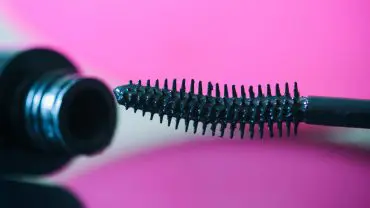The game of tennis can trace its origins back to medieval France. In the twelfth century, monks played a game known as ‘jeu de paume’, or ‘game of the palm’. This evolved into the complex game of real tennis around the fifteenth century, which itself morphed into the modern game.
Until the 1980s, tennis rackets were made of wood and rather basic in their construction. Today though, as players are faster, stronger, more accurate and hit at very high speeds, tennis racket technology has gone stratospheric.
Manufacturers are using robotics, space-age materials and physics to give players the competitive edge and to maximise performance. Read on to find out how tennis rackets are made.
What are Tennis Rackets Made Out Of?

Retro wooden tennis ball and racket (Photo: SEAN GLADWELL via Getty Images)
Tennis rackets are made with a variety of materials, but the most common is graphite. This is a lightweight, carbon-based material either used on its own or as a composite blend with materials such as Kevlar, carbon fibre, titanium, tungsten and fibreglass.
A 100% graphite frame has a stiff feel and favours players who rely on pure power, whereas a composite frame offers more flexibility and is preferred by players whose game is based on speed and accuracy.
If you’re researching what are tennis rackets made of, at the more affordable end of the market the answer is aluminium. It’s usually less hard-wearing than graphite or composite rackets, and doesn’t offer the power and control that more expensive rackets will.
How To Make a Graphite Tennis Racket

A modern tennis racket is often made from graphite. (Photo: NARANAT STUDIO via iStock)
The method of how tennis rackets are made is a lot more involved today than when they were made from wood. Like most things that are made with very specific manufacturing processes – such as chocolate, ice-cream or even cricket bats – the leading tennis racket manufacturers usually keep their methods closely guarded. However, the core principles of tennis racket manufacture are broadly the same whoever is making them.
Step 1 – Forming the outer shape
Strands of graphite are coated with resin and wound onto a drum. The layers are then cut into shapes and folded over one another by hand to form a stack of around ten layers. This material is then placed around a racket-shaped mould and formed into the basic shape of a tennis racket.
Step 2 – Heating the frame
The shaped frame is then put into an oven to harden into what becomes the final shape of the racket.
Step 3 – Cleaning
After the racket comes out of the oven, it is cleaned and all the excess material and residue is removed. It is then sanded with a fine abrasive to make the frame completely smooth and free of blemishes.
Step 4 – Inspection
Quality control is a vital element of every manufacturing process and the question ‘what are tennis rackets made out of’ is a combination of materials and the naked eye. Experts scour the rackets for abnormalities and they’re also put through a machine that picks up tiny imperfections.
Step 5 – Drilling
Not every tennis racket has the same string pattern (in fact most tennis rackets used by professionals are left unstrung so players can use their own strings tightened to suit their unique playing style). Each batch is drilled with a very specific string pattern.
Step 6 – Design
The paint is applied by machine but the brand stickers are often applied by hand.
Step 7 – The Handle
Another vital element in the process of how tennis rackets are made. The handle pallets and end cap are added and – as with the strings – grip size depends on the user. The racket is inserted into a machine that rotates and winds the grip around the handle. They used to be made of towelling or leather, but towel material got soggy with sweat and leather got very slippery. Today, most tennis grips are made from a synthetic material with cushioning and a shock-absorbing gel.
What is Tennis Racket String Made Of?

Midsection Of Man Making Tennis Racket (Photo: Juan Tesone / EyeEm via Getty Images)
When we are discussing what are tennis rackets made out of, we must also consider the strings. There are four main materials – synthetic gut, natural gut, multifilament and polyester.
Polyester
Polyester strings are a monofilament construction. They are exceptionally durable, but are very stiff and are generally only used by skilled players who can expertly control a tennis ball. However they do lose tension faster than other types of strings.
Synthetic Gut
Synthetic gut string is made from nylon and is a solid core string wrapped with layers of filaments. They are affordable and offer all-round playability but very few – if any – professionals use this material because they can have a tendency to snap if consistently hit with power.
Multifilament
A close-second to natural gut strings, multifilament strings use thousands of microfilaments to build up the string and offer excellent shock-absorption properties.
Natural Gut
When asking ‘what is tennis racket string made of’, perhaps the last answer you expect to hear is the intestines of a cow, but that’s exactly what natural gut strings are made from. They are very expensive but are elastic, comfortable to use, playable at high tensions and offer the optimum mix of power, spin and control.
Tennis Racket String - Gauge & Tension

A top view of a professional female tennis player having just served the ball during a tennis match (Photo : peepo via Getty Images)
If you play tennis for fun in the park you needn’t worry about gauge and tension, but for serious club players and professionals, these two elements are as important as how tennis rackets are made.
Gauge refers to the thickness of the strings. Thicker strings (around 1.35mm – 1.4mm) give players more control and durability, whereas thinner strings (around 1.1mm – 1.15mm) allow players more power and deeper spin.
Tension refers to how tight the strings are. Generally speaking lower tension strings allow the player to hit with more power and aggression and tighter strings offer more control and spin.












